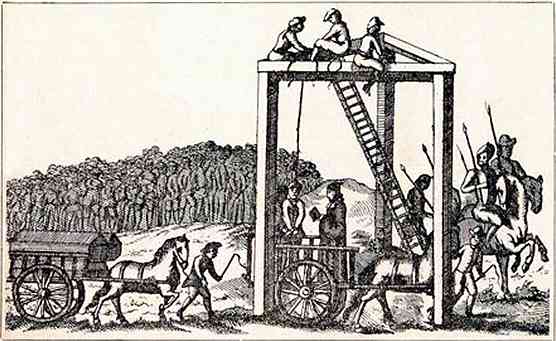For those familiar with London, "Marble Arch" is a familiar facet of the city, whether you know it by the tube stop or by the randomly placed monument. But long before tourists were wandering the area to gaze on the triumphal arch they were gathering by the hundreds to witness public executions. For the current location of Marble Arch is roughly located in the same place as the Triple Tree, the massive gallows designed for multiple and very public hangings.
 While many an 18th century highwayman met his end at Tyburn the site had been used for hangings since the medieval period. At first people would be lynched on the trees bordering the Tyburn river (a lost river which supposedly now flows underground). In 1571 a more efficient gallows was constructed, its unique form came to be iconic. Three posts eighteen feet high reached to the sky and met at the top to form a triangle. The horizontal crossbeams were nine feet across allowing for multiple people to be strung across. Not only was this design meant to be efficient in executing multiple people (rarely was there only one person executed at Tyburn) but it was also created with public viewing kept in mind.
While many an 18th century highwayman met his end at Tyburn the site had been used for hangings since the medieval period. At first people would be lynched on the trees bordering the Tyburn river (a lost river which supposedly now flows underground). In 1571 a more efficient gallows was constructed, its unique form came to be iconic. Three posts eighteen feet high reached to the sky and met at the top to form a triangle. The horizontal crossbeams were nine feet across allowing for multiple people to be strung across. Not only was this design meant to be efficient in executing multiple people (rarely was there only one person executed at Tyburn) but it was also created with public viewing kept in mind.Public executions were always a popular event to attend and Tyburn hangings always drew in a big crowd. William Hogarth immortalized the Tyburn crowds in his Industry and Idleness series. Monday was the big execution day, and for a fee you could get a seat in the stands specially built just to attend the hangings. Other spectators had to push and shove in the crowd to get a glimpse while pickpockets and prostitutes made use of the spectacle to get some money in their pockets.
Although the posts were extremely high, the condemned wouldn't fall far. The long fall, resulting in a broken neck from hanging wasn't utilized in public hangings until the mid 19th century. Criminals were drawn up to the gallows in a cart with a noose around their neck. The horse would be then be whipped so that the cart would be drawn away from the condemned and they would be left to swing and suffocate to their death. A tip to the carter would hopefully get the horses going slightly faster...not that it mattered much. Family members or hired persons would then grab on to the hanging bodies to add their weight in order to make the death swifter, otherwise a long agonizing death was imminent.
After the execution was performed the hangman would get your clothing, so choose your last outfit wisely (a nice waistcoat could mean a quicker execution). The bodies would then be given to the family to be buried or the hospital to be dissected.
The legendary triple tree was taken down in 1759 because it obstructed the roads. The large gallows was replaced by a movable one yet the spectacle of the hangings was still causing traffic problems in a city already burdened by traffic jams so public hangings at Tyburn officially ended in 1783 and were moved to Newgate Prison (where the condemned came from anyway).
While a nice marble triumphal arch is not as much of an eyesore as the Tyburn Tree, London still gives a nod to the legendary place where so many died and so many more were entertained by the criminals' demise. In the sidewalk, in front of gorgeous white-stone homes, a memorial stone lies on the site beside three bronze squares marking where each of the iconic eighteen foot posts once stood.



Out of topic. I do not know if you are a comic girl yourself but I found a really good one that I think you may like it.
ReplyDeleteThe books are written in French. There is a series about a couple during the French Revolution called «La guerre des Sambre» and a book inspired in the untold story behind a David painting: « the death of Bara» called «Le ciel aus-dessus du Louvre»
check it HERE
Intersting Article, I really enjoyed it. I wish we could have one of those in Mexico, so that the drug dealers could be hang there. I'm tired of this "No death penalty" nonsense...
ReplyDeleteWhat a fascinating post!
ReplyDeleteThank you for teaching me something new. Looking forward to visiting London Towne later this week, and will certainly be whizzing past Marble Arch and thinking of it's gruesome history.
@Fabu, Of course I will need to get my paws on them now!
ReplyDelete@Miss Honnete, one can only imagine!
@the Colonel, Now you have to make a stop to see the Tyburn location. I ran into it accidentally on one of my first trips to London.
Thanks for the post. I really enjoyed it. I wish they didn't remove it; it would be fun to visit.
ReplyDeleteOut of topic: Did anyone see Prince Poppycock last night?
Amazing...
Thanks for the reminder about that!
ReplyDeleteI worked at Marble Arch for many years in the 60s/70s and knew the gruesome history then, but isn't there some question about the EXACT location of the tree? Some say it's under 49 Connaught Square.
ReplyDeleteOh you would probably know better than I! I honestly wouldn't be too surprised considering how much the urban landscape changes.
Delete